展覧会について
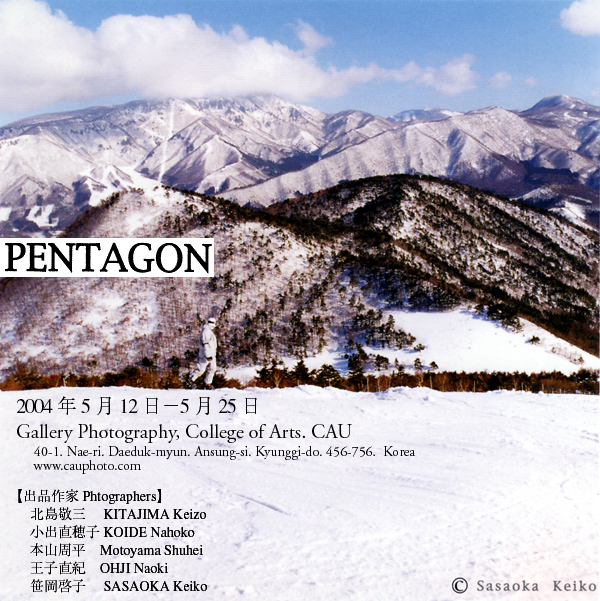
沖縄、名古屋、青森に続き、今回移動pg展としては初の海外での展覧会となった『PENTAGON』展。おもしろそうな場所であればどこでも展覧会をひらくという移動pg展にとってこの展覧会は記念すべき初海外進出の展覧会となりました。場所は、 韓国のソウル市内にあるGallery Photography, College of Arts. CAUという美術大学内の写真のギャラリーで、13日間開催されました。
展示の様子と写真評論家の飯沢耕太郎氏によるテキストを合わせて報告をします。
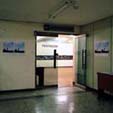

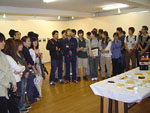
展示会場/出品作家/作品紹介

笹岡啓子/「観光」
SASAOKA Keiko/ KANKO
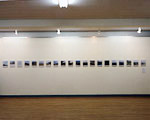
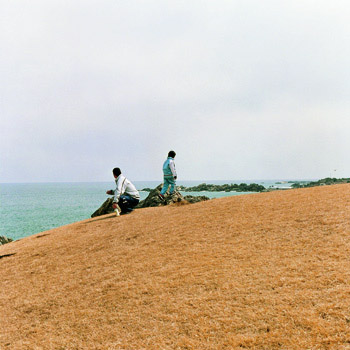
海岸や雪山の風景を中心に撮影しているシリーズ。 撮影地はこれまで三浦半島、房総半島を拠点に、沖縄県の糸満から青森県の竜飛岬、 北海道の積丹半島と日本各地におよぶ。
地図を見て、めずらしい地名やおもしろい地形を見つけては最寄駅まで行き、あとは成り行きまかせで、海沿いの国道を車でひた 走り、時にはとぼとぼと歩き、海へ続く釣り道を見つけては、気まぐれに曲がってみた。 崩れかけた遊歩道やただただ広いだけの砂浜を行くと、ふいに釣り人や漁師がいた。 真っ白だと思っていたキャンバスにふと陽射しがさしこんだ時のように、その人影の出現によって時間が流れ出し、生々しい世界に一変する。そうした生活圏と自然との 境界線とも言うべき場所でおこる私自身の不安定な知覚の変化を印画紙へ焼きつけている。
This series is focused on the scenery of the seashore and a snowcapped mountain. The locations are based in Miura Peninsula and Boso Peninsula and across Japan, from Shakotan Peninsula, Hokkaido toitoman in Okinawa. When I found an uncommon name of a place and an interesting topography on the map, I set feet at a nearby station and just leave it to chances. I drive the highway along the sea. Sometimes I round to narrow path. Sometimes I trudged along. I came across an angler and a fisherman at a collapsing promenade and merely miles of a white sand beach. As sunlight suddenly shines into a pure white canvas, occurrence of the shade made time flow, and the world changed into realistically vivid. I printed my own unstable alteration in perception which is found at fuzzy boundary between living area and nature.
王子直紀/「川崎」
OHJI Naoki /KAWASAKI
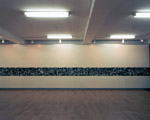
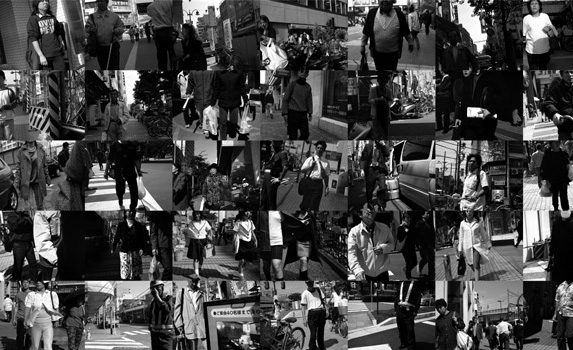
2000年から川崎を中心に撮影され、現在も進行中のこのシリーズ。もっとも一般的と もいえるスナップという手法を使い、これまで繰り返されてきたある一枚の写真に対 して意味や物語を求めてしまうような見方や、価値観を否定しようと開始された。 現在まで撮影された大量のイメージを安易に風景写真や人物写真と呼ぶことはできな い。また、それらを選ぶことなくそのまま提示しようとすることで、見る者は何かを 詮索する前にただ写るという当たり前のことを強く意識せざるを得ないのではないか。 展示方法も最近は合成した大量のイメージをデジタル出力して展示するなど、少しず つ変化を見せている。
I started this series on the year 2000, and am taking a picture mainly of Kawasaki. I try to deny the view and sense of values to seek the meaning and story from certain photograph that has been taken repeatedly, by common technique of snap shot in this series. A large amount of picture of image taken up to the present time cannot be easily called the landscape and portraits. Also exhibiting those pictures without careful choosing will only make viewers conscious of just picture itself, before something is scrutinized . Recent exhibition method is also changing. A digital output is carried out and a lot of compound image is exhibited.
小出直穂子/「赤い澱」
KOIDE Nahoko/ akai-ori
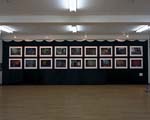
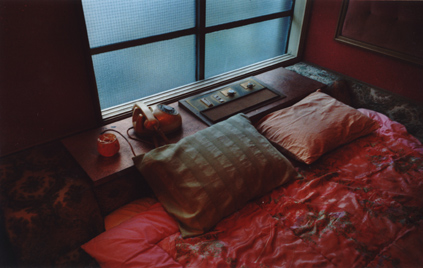
ベルベットの壁、薄暗い灯り、それらに照らされる薄っぺらな布団と部屋の闇・・かつて<赤線>と呼ばれ売春が行われていた町や、ラブホテルなどの性的な匂いのする場所、建物をカラーネガで撮影した作品。セックスのために作られた虚構の場所で、どれだけさまざまな人間が入り交じりそして消えてきたのか。写真には、静かに積み重ねられた澱のような何かが湿度を持ってまとわりついる。それは被写体となったそれらが滲ませる色の記憶なのかもしれない。
Velvet walls, dim lights, thin futons and darkness of the rooms… These color negative photos were taken in facilities and places with sexual atmosphere, such as “LOVE HOTELS” (accommodations for sexual intercourse) and areas once so-called “AKASEN” where prostitution was practiced. In these fictional places that were built for sex, uncountable number and kinds of people have come in and gone away. Inside of the photos, something like dregs that has tiered up quietly in time is creeping around with high humidity. Possibly, that is the memory of the color, which oozes out of the objects in the photos.
本山周平/「玄界灘アイランド」
GENKAINADA-ISLAND/ MOTOYAMA Shuhei
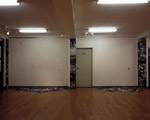
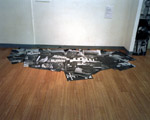 ▲ 展示風景。今まで出版されたSM TABLOIDが大量に展示された。
▲ 展示風景。今まで出版されたSM TABLOIDが大量に展示された。
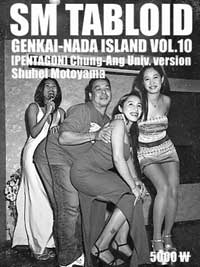 ■SM TABLOID
■SM TABLOID
韓国のChung-Ang Univでのグループ展[PENTAGON]バージョン。
「GENKAI-NADA ISLAND [PENTAGON]Chung-Ang Univ.version」
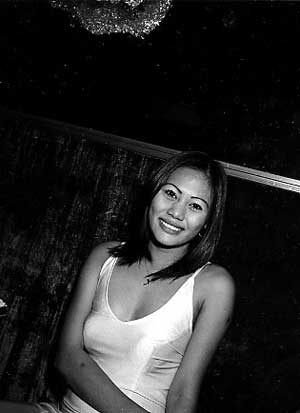
日本各地を取材し、発表も各地で行っている作者。展示と同時に発行してきた『SM TABLOID』シリーズも今回で10号目となる。今回は日本と韓国の国境の島と呼ばれている対馬をモノクロームにて撮影する。その土地によって作風の変化を見せる作者。今回はその島にどのような影響を受けるのか。
作品は、印刷媒体である『SM TABLOID VOL.10 GENKAINADA-ISLAND』(A3判16ページ)を150部、ギャラリーの床に展示する。
This photographer has been interviewing and putting on his exhibitions all over Japan. He is publishing Vol. 10 of his own paper series titled [SM TABLOID] which has been under way at the same time as these exhibitions. This volume will consist of monochrome pictures taken on the island of Tsushima which is a border island bang in between Japan and Korea. His style of photo’s change accordingly his surroundings. It’s a wonder to see what kind of pictures he will take at this location.
This product of 150 pieces (16 A3 pages) will be presented on the floor of the gallery at [SM TABLOID VOL.10 GENKAINADA-ISLAND].
PENTAGON展
東京新宿にあるphotographers’ galleryは2001年からスタートした「independent gallery」である。日本では1970年代後半から、写真家たちが自分たちで部屋を借りて運営するギャラリーの活動が続いてきた。これらのギャラリーは、カメラ・メーカーやフィルム・メーカーが経営するギャラリーや、プリントの販売を目的とする商業ギャラリーと違って、写真家たちが主体的に自分たちのやりたい企画を実現することができる。photographers’ galleryは新宿周辺に集中している、そんな「independent gallery」の中でも、もっとも意欲的に展示活動を展開しているギャラリーといえるだろう。 photographers’ galleryの活動で特筆すべきなのは、それが限られたメンバーの内側だけに留まることなく、常に「外」へ向けて開いていこうというエネルギーにあふれていることである。これまで沖縄、名古屋、弘前など日本各地でメンバーの展覧会をおこなってきた。またgalleryが運営するホームページ(www.pg-web.net/)を見ると、メンバー以外の参加者のコメントが常時掲載されており、刺激的な情報が飛びかっている。photographers’ galleryは「開かれたギャラリー」という、新たな形態を模索し、実現してきたのである。
さて、今回の韓国展では、5人のメンバーの作品が紹介される。
小出直穂子の「akai-ori」は、性的な空間に滲む気配を、細やかな感受性で探り出そうとするものである。それは見る者が心の奥にしまいこんできた危険な、だがどこか甘美な記憶を引き出してくれるだろう。
王子直紀は、東京近郊の街、川崎の路上で通行人をスナップし続けてきた。その膨大な集積から、日本人の身振りや表情の「原型」(プロトタイプ)が浮かび上がってくる。
本山周平は日本各地を移動しながら、それぞれの土地や被写体に同化して撮影を続けてきた。今回は日本と韓国の間に位置する対馬を対象にし、その微妙な社会的状況に迫る作品を発表する。
笹岡啓子は「観光」シリーズで、自然と人工的空間の境界にたたずむ人物にカメラを向けてきた。彼らの営みは、孤立しているようで、どこか互いに結びつき、何か大きな仕事を成し遂げようとしているようにも見える。
photographers’ galleryの活動の中心となってきた北島敬三は、「portraits」と「places」の2つのシリーズを発表する。「殻」と「場所」という写真家にとっての基本的なテーマを、あらためて定義し直そうとする意欲的な試みである。
この5人の作品が、韓国の観客にどのように受け取られるか、とても楽しみだ。もちろん彼らの仕事は多様に枝分かれして広がっている日本の現代写真の、限られた側面を示すにすぎない。それでもphotographers’ galleryの活動を通じて、その最前線のうごめきを感じとっていただけるのではないだろうか。
飯沢耕太郎(写真評論家)
Photographers’ gallery in Shinjuku, Tokyo, started in 2001 as what is called an ‘independent gallery’. It was in the late 1970’s that groups of photographers in Japan started to rent rooms and manage galleries on their own. Unlike the galleries managed by camera and film manufacturers and commercial galleries aimed to sell prints, these galleries allow photographers to realize the projects of their choice with independent-minds. Of the many independent galleries concentrated in and around Shinjuku, photographers’ gallery has carried out the most motivated exhibitions.
Special prominence should be given to the fact that their activities donユt intend to stay inside the group of limited members, but are always filled with the energy to go outward. Exhibitions have been held in many places in Japan, such as Okinawa, Nagoya, and Hirosaki. Also comments of the non-member participants can be found constantly among many pieces of stimulating information on the Internet website run by the gallery. (www.pg-web.net/) Photographers’ gallery has sought for a new form of a gallery and realized it as an ‘open’ one.
The works of five members are introduced in this exhibition in Korea.
Akai-ori by Nahoko Koide tries with delicate sensibility to catch the air spreading in a sexual space. Dangerous, but luscious memory put away deep inside oneユs heart would be brought out at the sight of it.
Naoki Ohji has been photographing the passersby on the streets of Kawasaki, a neighboring town of Tokyo. In his vast collection, ‘the prototypes’ of Japanese gestures and expressions can be seen through.
Shuhei Motoyama has traveled many places in Japan, taking photographs by assimilating with the places and the subjects. He chose Tsushima, an island located between Japan and Korea, as a subject for this exhibition. His work closes in on the subtle social situation this island faces.
Keiko Sasaoka in her kankou series directed her camera toward people who stand on the boundary between natural and artificial zones. Their pursuits seem individual, and at the same time somehow connected with one another, about to accomplish something enormous.
Keizo Kitajima, who has been at the center of the activities of the gallery, presents the two series of portraits and places. It is an aspiring challenge to re-define the basic themes for photographers, ‘core’ and ‘place’.
I am looking forward to seeing how the Korean audience would receive the works of these five people. It is true that their works only show a limited side of Japanese modern photography, which has been branching and growing in many different directions. However, through these activities of photographers’ gallery, the movements in its forefront are sure to be felt.
Koutaro Iizawa (critic)
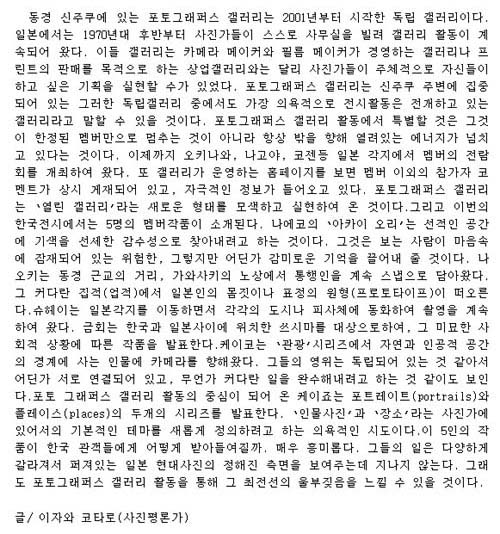












 ▲ 展示風景。今まで出版されたSM TABLOIDが大量に展示された。
▲ 展示風景。今まで出版されたSM TABLOIDが大量に展示された。 ■SM TABLOID
■SM TABLOID
